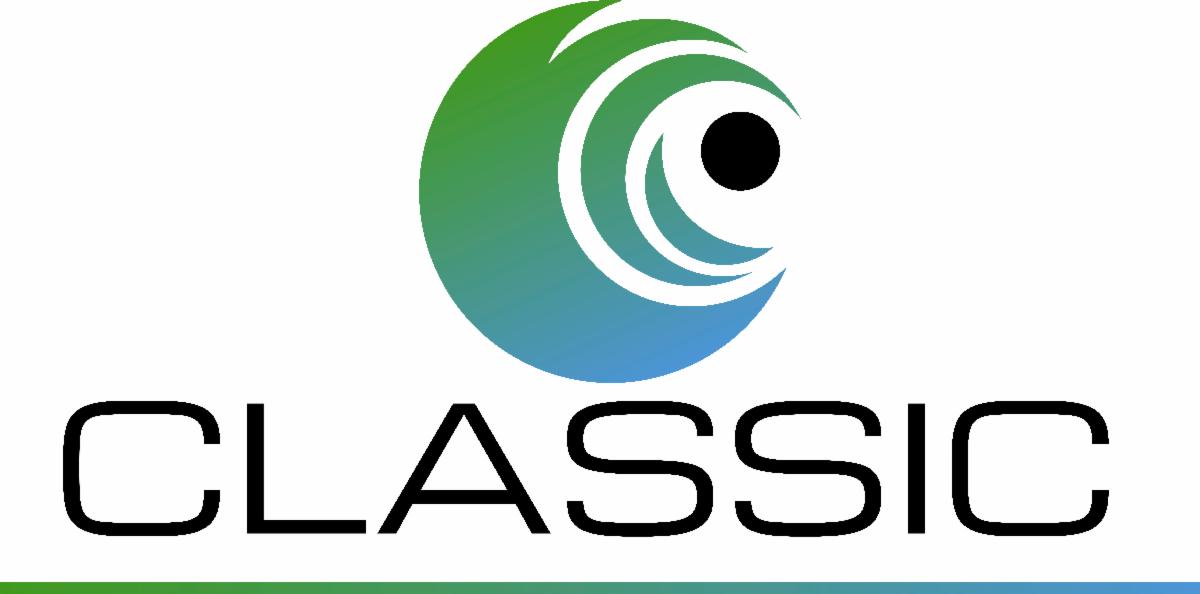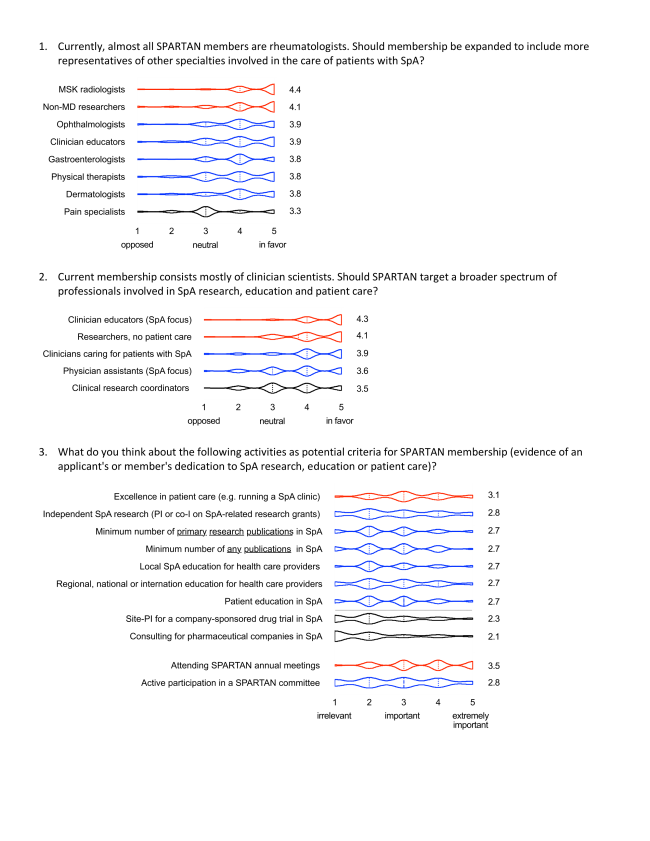|
Winter 2021 Volume 7 Issue 1
|
|
At SPARTAN, we are starting 2021 with both optimism and enthusiasm. Despite the continuing challenges from COVID-19, we are moving forward in pursuing the goals of our organization. SPARTAN continues to grow and explore new projects and efforts in spondyloarthritis. Looking forward, the SPARTAN member survey has demonstrated the need for diversifying the group to include other specialists and experts in spondyloarthritis.
The new year provides fresh opportunities for new trainees and faculty to apply for fellowship and faculty research grants and an opportunity to work on abstracts for the annual symposium.
This edition of the newsletter will also provide updates about the CLASSIC study and highlight the important events scheduled over the year.
Best wishes to all for health and safety in 2021.
Respectfully,
Judy
Judith A. Smith
SPARTAN Chair
|
There has been exciting news with more site activations and patient enrollments for the CLASSIC study. Currently we have 96 enrolled patients across 13 sit  es and central imaging reviews have been completed for 75 cases. These review sessions are attended by the local site Rheumatologists and Radiologist as well as 2 central reviewers. We have received very positive feedback from both the local sites and the central reviewers regarding the discussions had on these WebEx sessions. es and central imaging reviews have been completed for 75 cases. These review sessions are attended by the local site Rheumatologists and Radiologist as well as 2 central reviewers. We have received very positive feedback from both the local sites and the central reviewers regarding the discussions had on these WebEx sessions.
INTERESTING STUDY STATISTICS
#Cases (%)
| Data Summary
(90 Cases Total)
| Additional Information
| 34 (38%)
| Number of Cases (%) considered to have SpA by local Rheumatologist (5th Assessment)
| This is the total number of cases (out of 90 submitted as complete) where the local Rheumatologist (PI) indicated "YES" to SpA for the 5th and final global assessment
| 18 (20%)
| Number of Cases (%) considered to have SpA by central readers
| This is the total number of cases (out of 90 submitted as complete) where the central reviewers indicated "YES" to SpA. This includes cases where both reviewers agreed, as well as cases that went to adjudication where the adjudicator indicated "YES"
| 11 (12%)
| Number of Cases (%) requiring adjudication by central reader
| This is the total number of cases (out of 90 submitted as complete) that have triggered central reader adjudication. This means the imaging was reviewed by a 3rd reviewer (adjudicator). |
|
REFERRAL RECOMMENDATION STUDY
All submitted LOIs underwent formal review by the research committee who then submitted its recommendation to the Board of Directors in December 2020. After careful consideration of the reviews and recommendations, the Board invited the group of SPARTAN members lead by Abhijeet Danve and Maureen Dubreuil to submit a detailed proposal for the generation of SPARTAN referral recommendations for patients with chronic back pain who may have axial spondyloarthritis.
|
Foundation for the NIH Biomarker Consortium
Thanks to the work by John Reveille, SPARTAN is considering a partnership with the FNIH on a biomarker study. Stay tuned for updates and how members may be able to contribute to the project.
|
SAVE THE DATES!
SPARTAN Annual Meeting May 19-21, 2021
|
Due to continuing travel restrictions and uncertainties surrounding the COVID-19 pandemic, the annual SPARTAN symposium will be held virtually again this year.The trainee symposium will be held on May 19th from 11 am to 4 pm ET followed by the annual meeting on May 20th-21st. As in the past, the symposia will focus on scientific sessions, trainee and awardee (abstract) presentations, a year in review, and keynote lecture. The 3-day program will also offer opportunities for networking. Please mark your calendars!
|
The SPARTAN Annual Symposium organizing committee invites trainees to submit an abstract to the annual symposium. The deadline for submission is March 5, 2021. All abstracts will be evaluated by members of the abstract selection committee. Scientifically sound abstracts with relevance to spondyloarthritis (basic, clinical or translational research) will be accepted for poster presentation. The highest ranked abstracts will be invited for oral presentation.
Eligibility:
Trainees include students, residents, fellows and postdocs. Results should not already have been published in a peer-reviewed journal. Abstracts presented at other meetings within one year are eligible for submission. Abstracts submitted to the 2021 SPARTAN meeting may also be submitted to the ACR Annual Scientific meeting.
Logistics: The highest ranked abstracts will be presented during the scientific session. The remainder will be presented in individual breakout groups. Please note that we expect trainees with accepted abstracts to attend all sessions of the 2021 SPARTAN Annual Meeting.
Abstract Submission Fee: None.
Please submit an abstract for the meeting here by March 5 deadline.
|
Research Career Achievement Award
CALL FOR NOMINATIONS
|
The SPARTAN Research Career Achievement Award is awarded to SPARTAN members (and occasionally nonmembers) for outstanding contributions to clinical, translational or basic science research in spondyloarthritis. The award recognizes:
- Development of a cohesive, major research program
- Innovation
- Research productivity with impactful publications
Past winners have included Drs. Daniel Clegg, Muhammad Asim Khan, David Yu, Michael Weisman, Luis Espinoza, Robert Colbert, Maxime Dougados and John Reveille.
Please submit nominations by February 28, 2021 to Lisa Spiegel ([email protected]). Please include a paragraph that outlines the achievements of the nominee relevant to the three domains mentioned above. A formal letter of support is not required.
|

@SPARTAN_Updates
|
Performance of the ASAS Health Index for the Evaluation of Spondyloarthritis in Daily Practice
S. Alonso et.al.
The Journal of Rheumatology 2020;47:1483-9
doi:10.3899/jrheum.200025
This Spanish study aimed to test ASAS HI (a 17 item patient questionnaire) versus conventional assessment measures in daily practice. This cross-sectional study included 111 patients with axSpA classified by ASAS criteria in a northern Spain university hospital. From May to October 2019, sociodemographic, clinical, analytical and imaging data was collected. ASDAS-CRP, BASDAI and BASFI were performed as well as clinical SpA measurements. ASAS HI questionnaire was collected once for the assessment of disease effect on patients' lives.
74 men and 37 women had a mean age of 43.3 years and disease duration of 7.8 years. 16.2% (18) had peripheral arthritis. The average BASDAI was 3.4, ASDAS-CRP was 2.1 and BASFI was 2.95. 31.5% (35) of patients were in BASDAI remission and 15.3%(17) were in ASDAS inactive disease category. The average ASAS HI was 5.4 ± 3.8 with mean ASAS HI of 5.12 ± 3.94 in men and 6.08± 3.54 in women. The ASAS HI score tended to be higher in women with only question 1 "pain sometimes disrupts my normal activity" being significantly higher positive response in women (p=0.027). ASAS HI was higher in HLA-B27 negative (7.65) than HLA-B27 positive (4.86) patients. ASAS HI values ≤ 6 highly correlated with the BASDAI remission and ASDAS-CRP inactive disease. Spearman rho correlations were high between BASDAI, BASFI, and ASDAS-CRP (p<0.0005). ASAS HI construct convergent validity was high against BASDAI (rho 0.77, p<0.0005) and ASDAS (rho 0.70, p<0.0005).
There were several study limitations: 1)The study did not assess all phenotypes of SpA using this questionnaire. 2) As this was only a cross-sectional study, structural damage and its weight on disease activity were not assessed. 3) The sensitivity of the ASAS HI was not assessed as it was only collected on one occasion. Overall the patient questionnaire ASAS HI was a simple tool to apply in clinical practice that correlated well with BASDAI, BASFI, and ASDAS-CRP at one data point.
- Elizabeth Chang, MD
SPARTAN Communications Committee Member
High intensity exercise for 3 months reduces disease activity in axial spondyloarthritis (axSpA): a multicentre randomised trial of 100 patients
Silje Halvorsen Sveaas ,1 Annelie Bilberg,2 Inger Jorid Berg,3 Sella Arrestad Provan,3 Silvia Rollefstad,4 Anne Grete Semb,4 Kåre Birger Hagen,1 Melissa Woll Johansen,5 Elisabeth Pedersen,6 Hanne Dagfinrud1
Sveaas et al examined the question of high intensity exercise on disease activity and cardiovascular(CV) health in Axial Spondyloarthritis(AxSpA) patients. This was a 3-month, multicenter randomized controlled trial comparing the effects of high-intensity exercise compared with standard care in Norway & Sweden in medication-stable, patients meeting ASAS criteria for AxSpA. The interventional arm, high-intensity exercise('exercise-group'), consisted of 3 training sessions per week: two physiotherapist supervised weekly high intensity cardiorespiratory/strength exercises and one individual cardiorespiratory session. The control arm('control-group') patients were asked to maintain their usual physical activity. The primary outcomes were on disease outcome, BASDAI & ASDAS. Key secondary endpoints included AS-specific measures (BASFI & BASMI), cardiorespiratory fitness (estimated VO2 peak), muscle mass (DXA scan), and body-weight measures (weight, BMI, waist circumference). Assessors were blinded to trial arm of patients. These endpoints were analyzed in a reported intention-to-treat analysis post-treatment with p values of <0.05 considered statistically significant.
Of the 100 patients enrolled and randomized, 3 patients were los to f/u (2 exercise, 1control) and 4 patients did not complete exercise intervention with 97 patients (48 exercise-group, 49 control-group) were analyzed. Only 38/50 patients in the exercise-group were able to follow ≥80% of the prescribe exercises. There was a significant treatment effect of the intervention on the primary outcome (ASDAS: −0.6 [-0.8 to -0.3], and BASDAI: −1.2 [-1.8 to -0.7], p<0.001 furthermore with all components of disease activity showing statistically significant differences with the marginal exception of BASDAI-tenderness. Of the secondary endpoints, Estimated VO2 peak, BASFI, BASMI and Waist circumference were significantly different.
This study had strengths and flaws. Of the two main outcomes, BASDAI difference observed in the exercise vs. control group was also above the establish above minimally important improvement for clinical trials. The mean VO2 peak gains Technically, by excluding the 3 patients that were lost to follow up without a missing data plan violates ITT analysis although it may have altered the results significantly. The secondary outcome listed in the methods of muscle mass was also not analyzed or mentioned again in the manuscript. Lastly, while there was an estimated non-compliance of 10%, 24% of patients were unable to adhere to the exercise-program protocol despite the coordinator/physiotherapist support provided.
In conclusion, this article suggests that high-intensity exercise may be an efficacious intervention in treating disease activity and improving CV health in AxSpA patients. The effectiveness of this intervention however may require more pragmatic or longer-terms follow-up studies to better understand the feasibility of high-intensity exercise in our AxSpA patients.
- Mark Hwang, MD
SPARTAN Communications Committee Member
|
 2021 Global SpA Summit May 6-8, 2021 2021 Global SpA Summit May 6-8, 2021
SPARTAN Annual Meeting (virtual) May 20-21, 2021 and Trainee Symposium May 19. Deadline for abstract submission is March 5, 2021.
GRAPPA Annual Meeting July 8-10, 2021.
The 12th International Congress on Spondylarthritides in Gent, Belgium, had been postponed from October 2020 to April 2021, and now further postponed to September 9-11, 2021. Deadline for abstract submissions is March 31, 2021.
|
SPARTAN MEMBERSHIP SURVEY RESULTS
|
In October 2020, the governance committee conducted a survey to obtain feedback from current SPARTAN members to update the membership policy and 51.2% of SPARTAN members completed the online questionnaire. The results from the survey including free text comments are designed to help Board of Directors to update the SPARTAN membership policy.
In summary, the survey showed that SPARTAN members support the inclusion of non-rheumatologists, in particular musculoskeletal radiologists, non-MD researchers and spondyloarthritis clinical educators in the organization. The support for musculoskeletal radiologists was particularly strong and reflects the perception of an unmet need in this field. With regard to criteria for membership, members considered participation in SPARTAN annual meetings and excellence in patient care as the most important items. Excellence in patient care was ranked higher than independent research as a criterion for membership.

|
Thank you for the support
of our industry partners
|
|
|
|
Copyright © 2020. All Rights Reserved.
|
|
|
|